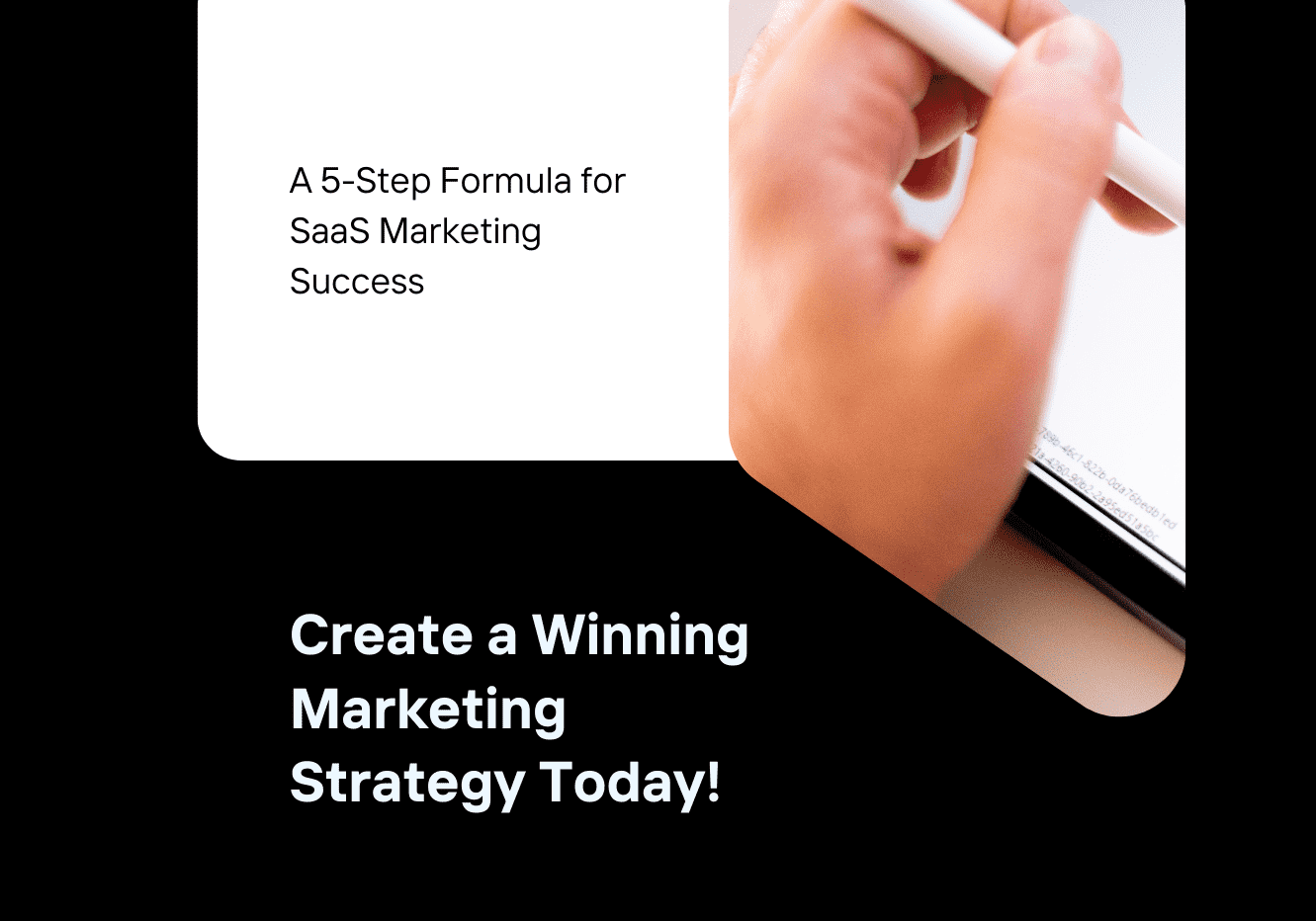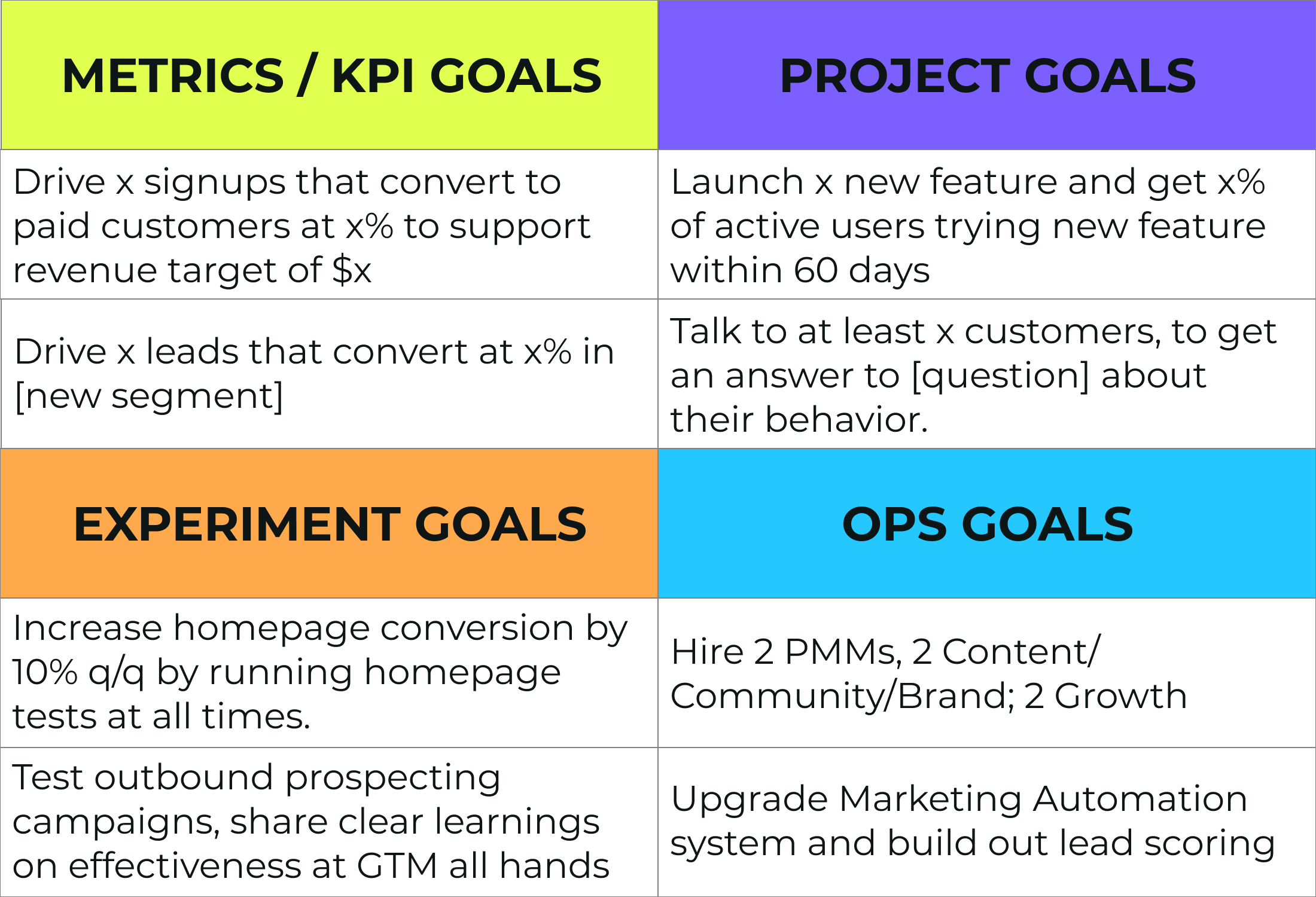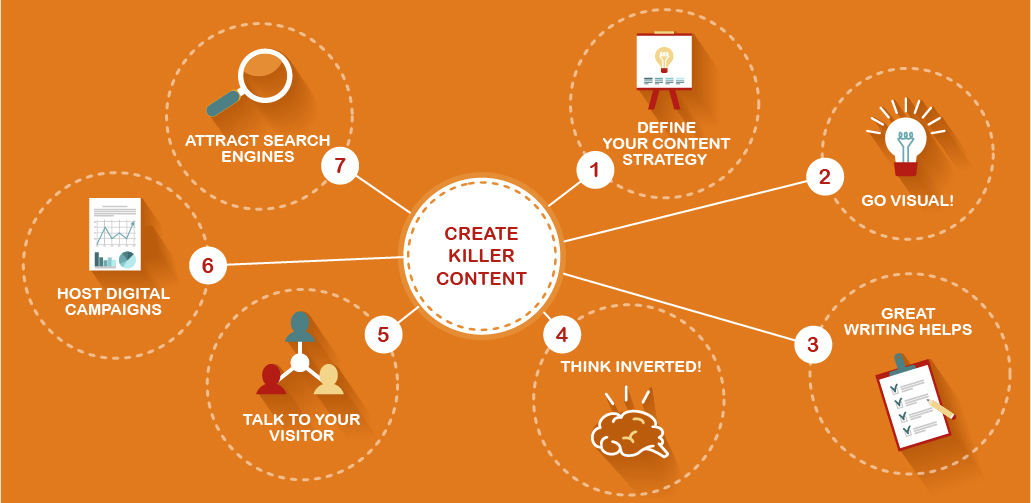"A successful SaaS marketing strategy is built on a foundation of deep customer insights, data-driven decision-making, and constant optimization."
I know you're here because you've got this fantastic SaaS product that you believe can make a real difference in your customers' lives. And I totally get it – you want to create an outstanding marketing strategy to share your product with the world and watch your business skyrocket. Well, guess what? You've come to the right place!

I'm going to share with you my very own 5-step formula for creating a winning SaaS marketing strategy that will help you connect with your audience, make your brand stand out, and ultimately achieve those big, beautiful business goals you have in mind.
So, cozy up with your favorite beverage, and let's get down to business. By the end of this article, you'll be equipped with all the knowledge and tools you need to craft a marketing plan that will transform your SaaS business.
Here's a sneak peek of what we'll cover:
- Understanding Your Audience: We'll dive deep into the minds of your target customers, creating buyer personas and mapping out the customer journey to ensure your marketing efforts hit the mark every time.
- Setting Clear Goals and KPIs: Together, we'll define SMART goals and identify the Key Performance Indicators that will help you measure and optimize your marketing success.
- Developing a Content Marketing Strategy: From performing a content audit to creating a content calendar and optimizing your content for SEO, we'll explore how to create a content strategy that attracts and retains customers.
- Leveraging Social Media and Influencer Marketing: We'll discuss how to choose the right social media platforms, develop a social media strategy, and collaborate with influencers to amplify your SaaS marketing efforts.
- Measuring, Analyzing, and Optimizing: Lastly, we'll look into the importance of tracking your KPIs, analyzing your data, and optimizing your marketing campaigns to continuously improve your results.
Ready to create a marketing strategy that will propel your SaaS business to new heights? Let's get started!
Step 1: Understand Your Audience
The first step in creating a winning marketing strategy is understanding your audience. It's important to know who your customers are, what they need, and how your product can help them. By understanding your target audience, you can craft a marketing message that resonates with them and leads to higher conversion rates.

1.1: Create Buyer Personas
Start by creating buyer personas for your target audience. A buyer persona is a semi-fictional representation of your ideal customer based on market research and real data about your existing customers. Here's a simple template to get you started:
- Demographics: Age, gender, location, income, education, etc.
- Job Role: Job title, company size, industry, etc.
- Goals: What are their main objectives and aspirations?
- Pain Points: What challenges do they face in achieving their goals?
- Preferred Channels: Where do they consume content? What social media platforms do they use?

1.2: Map Out the Customer Journey
The next step is to map out the customer journey. This is the path your customers follow from the moment they become aware of your SaaS product to the point of purchase (and beyond). Mapping out the customer journey will help you identify opportunities to engage with your audience and provide them with relevant content at each stage of their journey.
Here's an example of a simple customer journey:
- Awareness: Customer becomes aware of a problem they have and starts researching solutions.
- Consideration: Customer evaluates different SaaS products and compares their features and pricing.
- Decision: Customer selects your SaaS product and makes a purchase.
- Retention: Customer continues to use your product and, hopefully, refers others to it.

Step 2: Set Clear Goals and KPIs
Once you understand your audience, it's time to set clear goals and Key Performance Indicators (KPIs) for your marketing strategy. Goals are important because they provide a clear direction for your marketing efforts and allow you to measure your progress. KPIs, on the other hand, are the specific metrics you'll use to gauge the success of your marketing campaigns.
2.1: Define SMART Goals
When setting goals, make sure they are SMART:
- Specific: Clearly define what you want to achieve.
- Measurable: Ensure that you can track your progress.
- Attainable: Set goals that are challenging but possible to achieve.
- Relevant: Align your goals with your overall business objectives.
- Time-Bound: Set deadlines for achieving your goals.
Some example goals for your SaaS marketing strategy might include:
- Increase website traffic by 30% within 6 months
- Improve free trial sign-up conversion rate by 15% within 3 months
- Boost customer retention rate by 10% within 1 year
2.2: Identify Key Performance Indicators (KPIs)
Next, identify the KPIs that will help you measure your progress towards your goals. Some common KPIs for SaaS marketing strategies include:
- Website traffic
- Conversion rate
- Customer Acquisition Cost (CAC)
- Customer Lifetime Value (CLV)
- Churn rate
- Net Promoter Score (NPS)
Remember to track and analyze these KPIs regularly to ensure that your marketing efforts are on track and making progress towards your goals.

Step 3: Develop a Content Marketing Strategy
Content marketing is a crucial component of any successful SaaS marketing strategy. By creating valuable, relevant, and engaging content, you can attract and retain customers, improve your brand image, and drive more sales.
3.1: Perform a Content Audit
Start by performing a content audit. This involves taking inventory of all the content you currently have and evaluating its effectiveness. A content audit can help you identify gaps in your content strategy and determine which types of content you should focus on moving forward.
3.2: Create a Content Calendar
Next, create a content calendar to plan your content creation and distribution efforts. This will help you stay organized, ensure that you're consistently producing and sharing content, and keep your marketing efforts aligned with your goals.
A content calendar should include:
- Content topics and formats (e.g., blog posts, eBooks, webinars, etc.)
- Publishing dates and deadlines
- Distribution channels (e.g., email, social media, etc.)
- Target audience segments
3.3: Optimize Your Content for SEO
Finally, make sure your content is optimized for search engine optimization (SEO). This will help improve your visibility on search engines and drive more organic traffic to your website. Some SEO best practices include:
- Conducting keyword research to identify relevant and high-traffic keywords
- Including target keywords in your content, titles, meta descriptions, and URL structure
- Creating high-quality, valuable content that answers user queries
- Building a strong backlink profile through guest posting, outreach, and other link-building strategies

Step 4: Leverage Social Media and Influencer Marketing
Social media and influencer marketing are two powerful ways to amplify your SaaS marketing efforts. By leveraging these channels, you can expand your reach, engage with your audience, and drive more traffic and conversions.
4.1: Choose the Right Social Media Platforms
First, identify which social media platforms are most popular among your target audience. This might include:
- LinkedIn for B2B SaaS companies targeting professionals
- Twitter for tech-savvy users and industry influencers
- Facebook for B2C SaaS companies targeting a broader audience
- Instagram for visually-oriented SaaS products
4.2: Develop a Social Media Strategy
Next, develop a social media strategy that aligns with your overall marketing goals. This should include:
- Posting frequency and schedule
- Types of content to share (e.g., blog posts, videos, industry news, etc.)
- Engagement tactics (e.g., responding to comments, hosting Q&As, etc.)
- Social media advertising campaigns
4.3: Partner with Influencers
Influencer marketing can help you reach a larger audience, build trust, and drive more conversions. To get started, identify influencers within your niche who have a strong following and align with your brand values. Then, reach out to them and propose a collaboration, such as:
- Sponsored content (e.g., blog posts, videos, social media posts)
- Product reviews or testimonials
- Affiliate partnerships

Step 5: Measure, Analyze, and Optimize
The final step in creating a winning SaaS marketing strategy is to measure your results, analyze your data, and optimize your campaigns accordingly. This will help you identify what's working, what's not, and how you can improve your marketing efforts moving forward.
5.1: Track Your KPIs
Regularly track and monitor the KPIs you identified in Step 2. This will give you insight into the performance of your marketing campaigns and help you determine whether you're on track to achieve your goals.
5.2: Analyze Your Data
Go beyond just tracking your KPIs and dive deeper into your data. This might include analyzing:
- Website analytics (e.g., traffic sources, user behavior, conversion funnels, etc.)
- Social media analytics (e.g., engagement, reach, conversions, etc.)
- Email marketing metrics (e.g., open rates, click-through rates, conversions, etc.)
By analyzing your data, you can identify patterns and trends that can inform your marketing decisions.
5.3: Optimize Your Campaigns
Based on your data analysis, identify areas where your marketing efforts could be improved. This might involve:
- Adjusting your content strategy to focus on topics or formats that resonate with your audience
- Tweaking your social media posting schedule to reach more users
- Testing new email subject lines or CTAs to improve engagement and conversions
Remember that marketing is an ongoing process, and it's important to continuously test, learn, and optimize your campaigns to achieve the best results.
Creating a winning SaaS marketing strategy doesn't have to be complicated. By following this 5-step formula, you can build a solid marketing plan that helps you achieve your business goals, connect with your target audience, and grow your SaaS company. Just remember to:
- Understand your audience by creating buyer personas and mapping out the customer journey
- Set clear goals and KPIs for your marketing efforts
- Develop a content marketing strategy that includes a content audit, content calendar, and SEO optimization
- Leverage social media and influencer marketing to expand your reach and drive conversions
- Measure, analyze, and optimize your marketing campaigns to continuously improve your results
Now that you have the tools and knowledge you need, it's time to start building your winning SaaS marketing strategy. Good luck, and happy marketing!
FAQ
1. How do I know which marketing channels to focus on for my SaaS business?
It's important to focus on the marketing channels that are most relevant to your target audience and align with your overall marketing goals. Start by researching your target audience's online habits and preferences, and consider the unique benefits and drawbacks of each marketing channel. You may also want to test different channels and analyze their performance to determine which drive the best results for your business.
2. How often should I publish new content on my blog?
The optimal posting frequency for your blog depends on your specific goals, resources, and audience. It's important to strike a balance between maintaining consistency and ensuring high-quality content. Some SaaS businesses publish new content multiple times a week, while others post only once or twice a month. The key is to find a schedule that works best for you and your audience, and then commit to it. Remember that consistency is more important than frequency.
3. How can I optimize my content for search engines (SEO)?
To optimize your content for search engines, follow these best practices:
- Research and target relevant keywords: Use tools like Google's Keyword Planner, Moz, or Ahrefs to identify keywords that your audience is likely to search for and have a reasonable level of competition.
- Include your target keywords in strategic locations: Place your primary keyword in your title, headings, URL, and meta description, and use it naturally throughout your content.
- Write high-quality, in-depth content: Focus on providing value to your readers by addressing their pain points, answering their questions, and offering actionable advice. Longer, more comprehensive articles tend to perform better in search engine rankings.
- Optimize your images: Use descriptive file names and alt tags, and compress your images to improve page load times.
- Build internal and external links: Link to other relevant content on your website, and earn backlinks from reputable external sources to boost your authority and rankings.
4. How can I grow my email list for my SaaS business?
To grow your email list, try these tactics:
- Offer valuable lead magnets: Create high-quality, relevant resources (e.g., ebooks, templates, checklists) that your target audience would be interested in, and offer them in exchange for their email address.
- Use exit-intent pop-ups: Display a pop-up with an enticing offer just as visitors are about to leave your website, encouraging them to sign up for your email list.
- Promote your email list on social media: Share teasers of your newsletter content, and invite your followers to join your email list to receive exclusive content and offers.
- Add a sign-up form to your blog: Place an email sign-up form in strategic locations on your blog, such as the sidebar, within blog posts, or in your website footer.
- Run targeted ads: Use platforms like Facebook or Google Ads to promote your lead magnets and email list to a larger audience.
5. How can I measure the ROI of my content marketing efforts?
To measure the ROI of your content marketing efforts, follow these steps:
- Define your goals and KPIs: Clearly outline your content marketing objectives and the key metrics you'll use to measure success.
- Track your performance: Use tools like Google Analytics and UTM parameters to monitor your KPIs and attribute conversions to specific content pieces.
- Calculate your content marketing costs: Include the cost of content production (e.g., writer fees, graphic design), content promotion (e.g., paid ads, influencer partnerships), and any tools or software used in your content marketing efforts.
- Calculate your ROI: Use this formula: ROI =(Return on Investment) = (Revenue from content marketing - Content marketing costs) / Content marketing costs. This will give you a percentage value that represents the return on investment for your content marketing efforts.
6. How do I choose the right influencers for my SaaS business?
To choose the right influencers for your SaaS business, consider the following factors:
- Relevance: Ensure that the influencer's niche aligns with your industry, and their content resonates with your target audience.
- Engagement: Look for influencers with high engagement rates (e.g., likes, comments, shares), as this indicates a strong connection with their followers.
- Authenticity: Choose influencers who have a genuine interest in your product and share honest, unbiased opinions with their audience.
- Reach: Consider the influencer's follower count, but don't focus solely on large numbers. Smaller, niche influencers with a highly engaged audience can often yield better results.
- Track record: Research the influencer's past collaborations to assess their success and professionalism.
7. How can I improve my SaaS website's conversion rate?
To improve your SaaS website's conversion rate, try these tactics:
- Simplify your website design: Create a clean, visually appealing, and easy-to-navigate website that clearly communicates your value proposition.
- Optimize your CTAs: Use clear, actionable language, and make your CTAs stand out with contrasting colors and prominent placement.
- Add social proof: Showcase customer testimonials, case studies, and industry awards to build trust and credibility.
- Offer personalized content: Use dynamic content and segmentation to provide tailored experiences based on your visitors' preferences and behaviors.
- Run A/B tests: Continuously test and optimize various elements of your website, such as headlines, images, and form fields, to identify improvements that boost conversions.
8. How do I reduce churn and improve customer retention for my SaaS business?
To reduce churn and improve customer retention, implement these strategies:
- Focus on customer success: Provide resources, training, and support to help your customers achieve their goals using your product.
- Regularly gather feedback: Use surveys, interviews, and NPS scores to understand your customers' needs, pain points, and satisfaction levels, and address any issues promptly.
- Communicate proactively: Keep customers informed about product updates, new features, and relevant content to demonstrate your ongoing commitment to their success.
- Offer incentives for long-term commitment: Encourage customers to commit to longer subscription plans with discounted pricing or exclusive features.
- Identify at-risk customers: Monitor usage data and engagement metrics to identify customers who may be at risk of churning, and reach out to them with personalized support and offers.
9. What are some effective ways to promote my SaaS product?
Effective ways to promote your SaaS product include:
- Content marketing: Produce high-quality, valuable content that addresses your audience's needs and pain points, and promotes your product as a solution.
- Social media marketing: Share your content, product updates, and promotional offers on social media platforms where your target audience is active.
- Influencer marketing: Collaborate with influencers in your niche to promote your product to a larger, more engaged audience.
- Email marketing: Nurture leads and customers with personalized email campaigns that offer valuable content, product information, and special offers.
- Webinars and events: Host webinars, workshops, or live events to showcase your product's features, benefits, and use cases, and provide an opportunity for Q&A.
10. How can I ensure that my SaaS marketing strategy remains effective over time?
To ensure that your SaaS marketing strategy remains effective over time, follow these guidelines:
- Regularly review and update your buyer personas: As your business and target audience evolve, your buyer personas may need to be updated to reflect these changes. Revisit your personas periodically and make adjustments as needed to ensure your marketing efforts stay relevant.
- Monitor and analyze your KPIs: Keep a close eye on the performance of your marketing initiatives by tracking key metrics. This will help you identify trends, areas for improvement, and opportunities for growth.
- Continuously test and optimize: Regularly run A/B tests on your marketing assets (e.g., website, email campaigns, ad creatives) to identify opportunities for optimization and improve your overall marketing performance.
- Stay informed about industry trends: Keep up-to-date with the latest developments in your industry and the world of marketing by following industry blogs, attending webinars, and participating in relevant online communities. This will help you stay ahead of the curve and adapt your marketing strategy to changing circumstances.
- Solicit and incorporate feedback: Regularly gather feedback from your customers, team members, and other stakeholders to identify areas of improvement and uncover new opportunities for your marketing strategy. Be open to criticism and willing to adjust your approach as needed to ensure ongoing success.
By following these guidelines, you can keep your SaaS marketing strategy agile and effective, ensuring that it continues to drive growth and success for your business over time.






